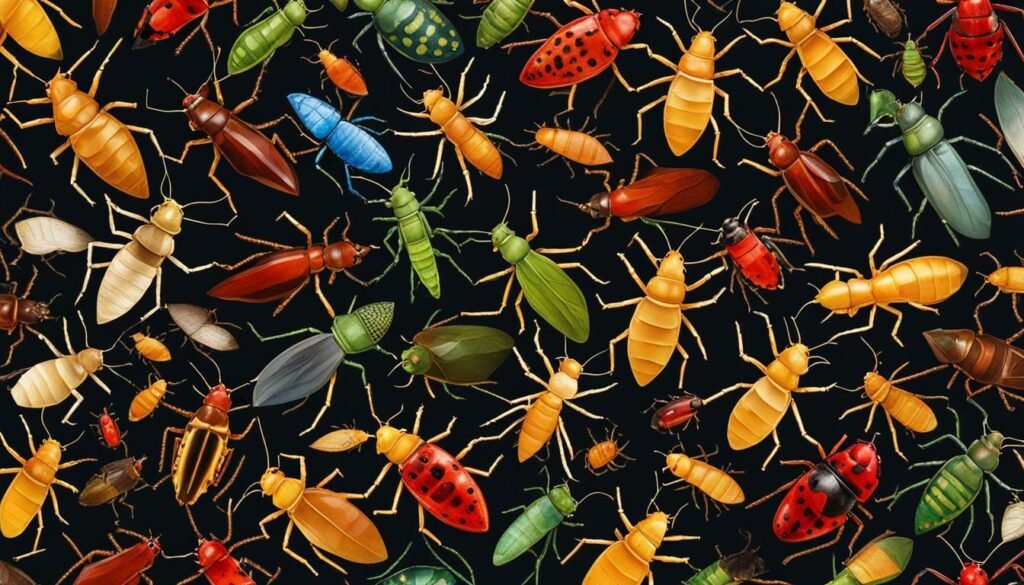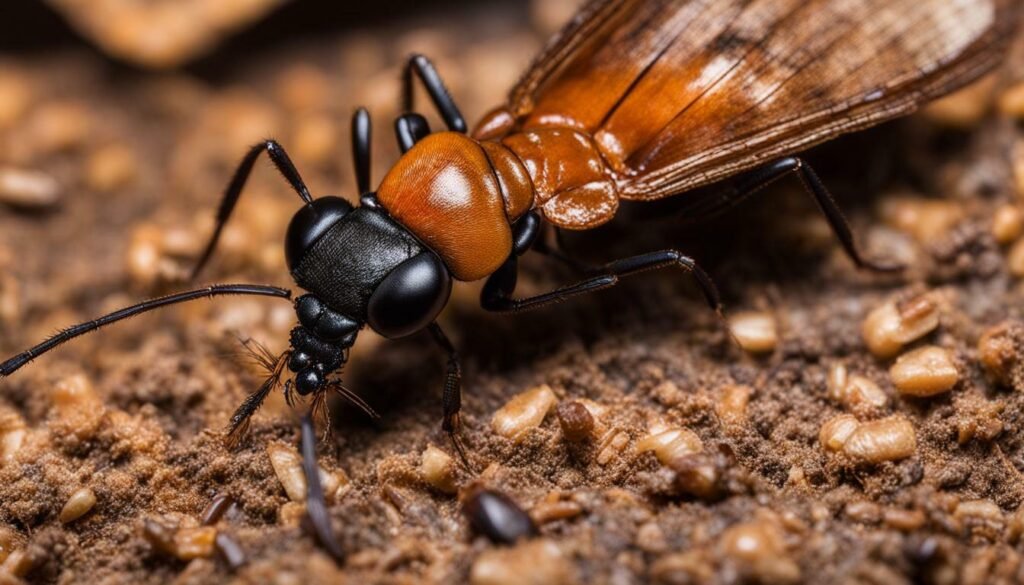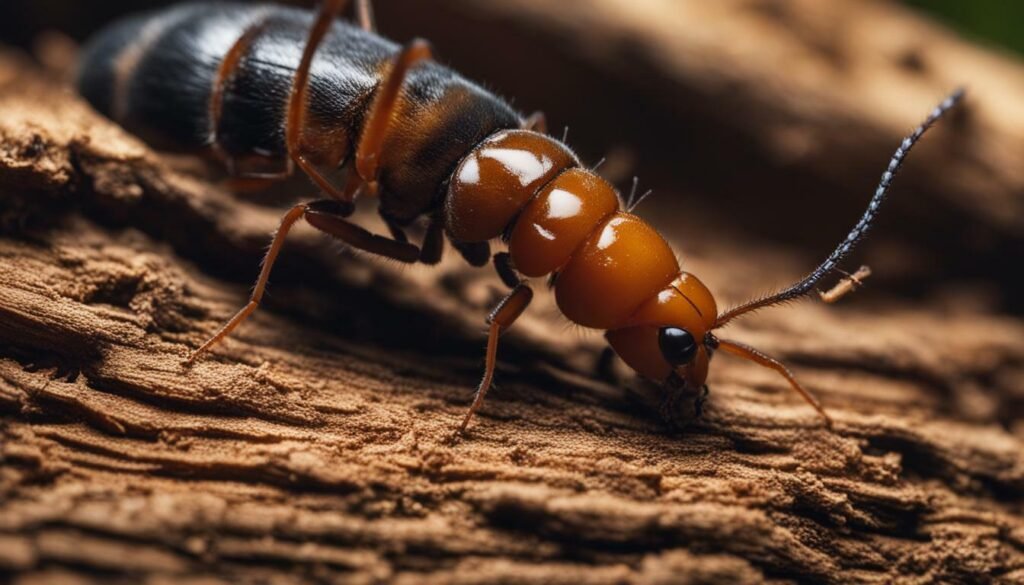If you’re wondering whether termite treatment can help eliminate other pests, you’ve come to the right place. Termite treatments, such as liquid termiticides and bait stations, have been known to effectively eliminate other bugs in addition to termites. The powerful formula used in these treatments can combat pests like ants, beetles, bed bugs, cockroaches, and spiders. However, it’s important to note that not all termite treatments are designed to target other pests, so it’s crucial to choose the right treatment for your specific pest problem.
Key Takeaways:
- Termite treatments have the potential to kill other bugs like ants, beetles, bed bugs, cockroaches, and spiders.
- Not all termite treatments are effective against other pests, so it’s important to choose the right treatment for your specific pest problem.
- The strength of the formula used in termite treatments allows them to be effective in combating other pests.
- Termite treatments are generally safe for pets, but it’s advised to keep them away from treated areas for a period of time after treatment.
- By selecting the appropriate termite treatment, you can effectively address multiple pest issues in your home.
Understanding Termite Treatments and Their Impact on Other Bugs
Termite treatments are designed to target termites, but they can also have an impact on other common pests. The strength of the formula used in these treatments allows them to be effective against pests like ants, beetles, bed bugs, cockroaches, and spiders. However, not all termite treatments are formulated to work against other pests, so it is important to choose the right treatment for the specific pest problem.
When termites come into contact with the treated areas, the insecticide in the termite treatment is ingested or absorbed through their exoskeleton. This insecticide then attacks their nervous system, leading to paralysis and eventually death. The same mechanism applies to other pests that may come into contact with the treated areas.
It’s important to note that different termite treatments may have varying levels of effectiveness against other pests. Some treatments, like liquid termiticides, can create a protective barrier around the treated area, preventing pests from entering your home. On the other hand, bait stations can attract and eliminate pests that feed on the bait, effectively reducing their populations.
While termite treatments are generally safe for pets, it is advisable to keep them away from the treated areas for a period of time after treatment. This ensures that they do not come into direct contact with the insecticide, which may cause irritation or other adverse effects. Follow the instructions provided by the pest control professional and take necessary precautions to keep your pets safe during and after termite treatment.


Types of Termite Treatments That Target Other Bugs
There are several types of termite treatments that are specifically designed to target other insect species. For example, some treatments combine termiticides with insect growth regulators, which disrupt the growth and development of pests like cockroaches and ants. Others may utilize specific bait formulations to attract and eliminate specific pests.
By choosing the right termite treatment that targets other bugs, you can effectively address multiple pest problems at once. Consult with a pest control professional to determine the most suitable treatment option for your specific needs. They can assess the extent of the infestation, identify the pests involved, and recommend the appropriate treatment plan.
| Type of Termite Treatment | Targeted Pests | Effectiveness |
|---|---|---|
| Liquid termiticides | Termites, ants, beetles, bed bugs, cockroaches, spiders | High |
| Bait stations | Termites, ants, cockroaches | Moderate |
| Termiticides with insect growth regulators | Cockroaches, ants | High |
| Baits with specific formulations | Ants, cockroaches, beetles | Variable |
Effectiveness of Termite Treatment on Other Pests
Termite treatments can be a comprehensive pest control solution, effectively eliminating other insect species as well. When it comes to dealing with pests like ants, beetles, bed bugs, cockroaches, and spiders, termite treatments, such as liquid termiticides and bait stations, have proven to be highly effective.
The strength of the formula used in these treatments ensures that they are not only lethal to termites but also to other pests that may be infesting your home. This means that by treating your property for termites, you can also address other pest problems simultaneously, saving you time and money on separate treatments.
However, it is important to note that not all termite treatments are formulated to work against other pests. Therefore, it is crucial to choose the right treatment for your specific pest problem. Consulting with a professional pest control expert can help you determine the most suitable termite treatment that will effectively eliminate the targeted pests.
| Pest | Effectiveness of Termite Treatment |
|---|---|
| Ants | High effectiveness |
| Beetles | High effectiveness |
| Bed bugs | High effectiveness |
| Cockroaches | High effectiveness |
| Spiders | High effectiveness |
Additionally, it is worth noting that termite treatments are considered safe for pets. However, as a precautionary measure, it is recommended to keep pets away from treated areas for a certain period of time after the treatment. This will ensure their safety and minimize any potential risks associated with the chemicals used in the treatment process.


In conclusion, termite treatments have proven to be effective in eliminating other insect species in addition to termites. By choosing the right treatment and following safety precautions, you can effectively address multiple pest problems and ensure a pest-free environment for your home and pets.
Types of Bugs Termite Treatments Can Target
Termite treatments have been shown to effectively target and eradicate a wide range of insect species, including ants, beetles, bed bugs, cockroaches, and spiders. The powerful formulas used in these treatments make them highly effective against these pests, helping to eliminate infestations and prevent further damage. Here is a breakdown of how termite treatments can impact these common bugs:
1. Ants: Termite treatments can be effective in eliminating ant colonies, especially if they overlap with termite activity. The insecticides used have a broad spectrum of action, which can help to control ant populations.
2. Beetles: Certain species of beetles, such as wood-boring beetles, can cause significant damage to wooden structures. Termite treatments that target termites can also help to eliminate these destructive beetles, protecting your property from further harm.
3. Bed Bugs: While not directly related to termites, bed bugs are a common household pest that can cause discomfort and distress. Some termite treatments, especially those that use residual insecticides, can also be effective in eradicating bed bug infestations.
4. Cockroaches: Cockroaches are known for their resilience and ability to survive in various environments. However, termite treatments can be successful in controlling cockroach populations, particularly when applied correctly and targeted to their hiding places.
5. Spiders: While termites and spiders are not closely related, termite treatments can help reduce spider populations indirectly. By eliminating their food source (termites) and creating an environment that is less favorable for spiders, such treatments can contribute to spider control.
It is important to note that the effectiveness of termite treatments on other pests may vary depending on the specific product used and the severity of the infestation. Consulting with a professional pest control provider can help determine the most appropriate treatment for your specific pest problem.


Choosing the Right Termite Treatment for Multiple Pest Problems
When faced with multiple pest problems, it’s crucial to choose a termite treatment that offers a comprehensive pest control solution. Termite treatments, such as liquid termiticides and bait stations, have been known to kill other pests in addition to termites. The strength of the formula used in these treatments allows them to be effective against pests like ants, beetles, bed bugs, cockroaches, and spiders.
However, not all termite treatments are formulated to work against other pests, so it is important to select the right treatment for your specific pest problem. To determine the most suitable solution, consider consulting a professional pest control expert who can assess the extent of your pest infestation and recommend the appropriate termite treatment that targets both termites and other pests.
One effective termite treatment option is the use of liquid termiticides, which are applied to the soil around your property’s perimeter. These treatments create a protective barrier that not only eliminates termites but also acts as a deterrent for other crawling insects. Additionally, bait stations can be strategically placed to attract and eliminate multiple pests in your home or business.
| Termite Treatment Type | Targeted Pests |
|---|---|
| Liquid Termiticides | Termites, ants, beetles, bed bugs, cockroaches, spiders |
| Bait Stations | Termites, ants, cockroaches, spiders |
Remember, when opting for a termite treatment that also targets other pests, it is essential to follow the instructions provided by the manufacturer or the pest control professional. This ensures the safety and effectiveness of the treatment and minimizes any potential risks to you, your family, and your pets.
It’s advisable to keep pets away from treated areas for a period of time after the termite treatment. While termite treatments are generally safe for pets, it’s best to take precautions by limiting their access to the treated areas. Consult with your pest control expert for specific guidelines on how to protect your pets during and after the termite treatment process.


Our Expert’s Recommendation
“Choosing a termite treatment that effectively addresses multiple pest problems requires careful consideration. Liquid termiticides and bait stations are proven to be effective against various pests, providing a comprehensive pest control solution. However, it’s important to consult with a pest control professional to assess the extent of your infestation and determine the most suitable treatment option.”
By selecting a termite treatment that targets multiple pest problems, you can effectively eliminate termites and other crawling insects, safeguarding your property from potential damage and creating a pest-free environment. Prioritize the health and well-being of your family and pets by choosing a termite treatment that offers a comprehensive solution to your pest issues.
Safety of Termite Treatments for Pets
Termite treatments are generally safe for pets, but it’s important to take precautions to protect them during the treatment process. While the formula used in termite treatments can be effective in eliminating other pests, it’s essential to ensure the well-being of your furry friends. Here are some key tips to keep in mind:
- Keep pets away from treated areas: After a termite treatment, it’s crucial to keep your pets away from the treated areas. The chemicals used in the treatment may not be harmful to humans or pets, but it’s best to minimize their exposure as a precaution.
- Provide temporary accommodation: If the treatment involves indoor areas where your pets usually reside, consider finding temporary accommodation for them during the treatment process. This can help prevent any accidental contact with the treated surfaces.
- Follow professional advice: When scheduling a termite treatment, consult with the pest control professional who will be conducting the treatment. They will provide specific instructions on how to ensure the safety of your pets during and after the treatment.
Remember, even though termite treatments are generally safe for pets, it’s always better to be cautious and take necessary steps to protect them. Following these guidelines will help ensure the well-being of your pets while effectively addressing your termite and pest problems.
For more information on how to protect your pets during termite treatments, consult your local pest control provider or veterinarian. They can provide specific guidance based on the type of treatment being conducted and the needs of your pets.


Keeping Pets Away from Treated Areas
To ensure the safety of your pets, it’s essential to keep them away from areas that have been treated for termites. While termite treatments are generally safe for pets, it’s important to exercise caution during and after the treatment process. The chemicals used in termite treatments can pose potential risks to your furry friends if they come into direct contact with them or ingest treated materials.
During the termite treatment, make sure to confine your pets to a separate area of your home or keep them outdoors. This will prevent them from accidentally entering the treated areas and minimize any possible exposure to the chemicals. Additionally, remove any pet food, water bowls, and toys from the treated areas before the treatment begins to avoid contamination.
After the termite treatment is completed, it’s advisable to keep your pets away from the treated areas for a specific period of time. The duration may vary depending on the type of treatment used, so it’s best to consult with your pest control professional for specific guidelines. Taking these precautions will help ensure that your pets remain safe and free from any potential harm associated with the termite treatment.
Remember, the safety and well-being of your pets are of utmost importance. While termite treatments are an effective way to eliminate pests, it’s crucial to follow proper precautions to protect your furry companions.


| Do’s: | Don’ts: |
|---|---|
|
|
Types of Termite Treatments That Target Other Bugs
Some termite treatments are formulated to target and eliminate other insect species, in addition to termites. These treatments are designed to provide a comprehensive pest control solution, effectively eradicating multiple pests in one go. If you’re dealing with a pest problem that extends beyond termites, these specialized termite treatments can be a game-changer.
One common type of termite treatment that targets other bugs is liquid termiticides. These insecticides are applied directly to the soil around your home, creating a barrier that not only kills termites but also eliminates other crawling insects. The strength of the formula used in liquid termiticides allows them to be effective against pests like ants, beetles, bed bugs, cockroaches, and spiders, giving you peace of mind knowing that multiple pests are being dealt with in one treatment.
Another type of termite treatment that can target other bugs is the use of bait stations. These stations are strategically placed around your property and contain a slow-acting poison that termites carry back to their colony, effectively eliminating the entire termite population. However, some bait stations are also designed to attract and kill other insects, providing a more comprehensive approach to pest control.
| Termite Treatment | Target Pests |
|---|---|
| Liquid Termiticides | Termites, ants, beetles, bed bugs, cockroaches, spiders |
| Bait Stations | Termites, ants, beetles, bed bugs, cockroaches, spiders |
It is important to note that not all termite treatments are formulated to work against other pests. If you are dealing with a specific pest problem, it is crucial to choose a treatment that is targeted towards that particular pest. Consulting with a pest control professional can help you determine the most effective termite treatment for your specific situation and ensure that all pests are properly addressed.


While termite treatments can effectively eliminate other bugs, it is essential to prioritize the safety of your pets during and after treatment. Although most termite treatments are considered safe for pets, it is recommended to keep them away from treated areas for a period of time. This helps minimize their exposure to any potential risks associated with the chemicals used in the treatment. Consult with your pest control professional for specific instructions on how to ensure the well-being of your furry friends.
Conclusion
Termite treatments have proven to be an effective solution not only for eliminating termites but also for eradicating other insect species, providing comprehensive pest control. The strength of the formulas used in these treatments allows them to effectively target pests such as ants, beetles, bed bugs, cockroaches, and spiders. However, it is important to note that not all termite treatments are formulated to work against other pests.
When selecting a termite treatment for your specific pest problem, it is essential to choose the right type of treatment that is designed to target the particular insects you are dealing with. Liquid termiticides and bait stations are commonly used treatments that have been known to be effective against a range of pests. These treatments work by either directly killing the insects upon contact or by disrupting their life cycles, ultimately leading to their eradication.
In addition to their effectiveness, termite treatments are also safe for pets. However, it is recommended to keep your furry friends away from treated areas for a period of time after the treatment. This precaution ensures that your pets do not come into contact with any residual chemicals and minimizes their exposure to potential risks.
In conclusion, termite treatments offer not only targeted termite control but also a comprehensive solution for other insect infestations. By choosing the right treatment and following the necessary safety measures, you can effectively eliminate pests and create a pest-free environment for you and your loved ones.
FAQ
Q: Will termite treatment kill other bugs?
A: Yes, termite treatments have been known to kill other pests in addition to termites. The strength of the formula used in these treatments allows them to be effective against pests like ants, beetles, bed bugs, cockroaches, and spiders.
Q: Are termite treatments safe for pets?
A: Yes, termite treatments are generally safe for pets. However, it is important to keep pets away from treated areas for a period of time after treatment to minimize their exposure to any potential risks.
Q: How do I choose the right termite treatment for my pest problem?
A: It is important to choose the right termite treatment for the specific pest problem you are facing. Consider consulting a professional pest control expert who can assess your situation and recommend a comprehensive pest control solution that can effectively address multiple pest issues.
Q: Can termite treatments target other bugs?
A: Yes, there are types of termite treatments that are specifically designed to target and eliminate other insect species. These treatments can be an effective solution for eradicating bugs beyond just termites.
Q: How long should I keep my pets away from treated areas?
A: It is recommended to keep pets away from treated areas for the duration specified by the pest control professional or product instructions. This typically ranges from a few hours to a few days to ensure their safety.
Source Links
- https://www.loyalpest.com/termites/treatment/will-termite-treatment-kill-other-bugs/
- https://andersonpestsolutions.com/termites/treatment/will-termite-treatment-kill-other-bugs/
- https://amcoranger.com/faq/will-termite-treaments-kill-ants/
Your Expert in Animal Control and Extermination. Trust our experience for humane, effective pest management, protecting your property and ensuring peace of mind with Michael S.





